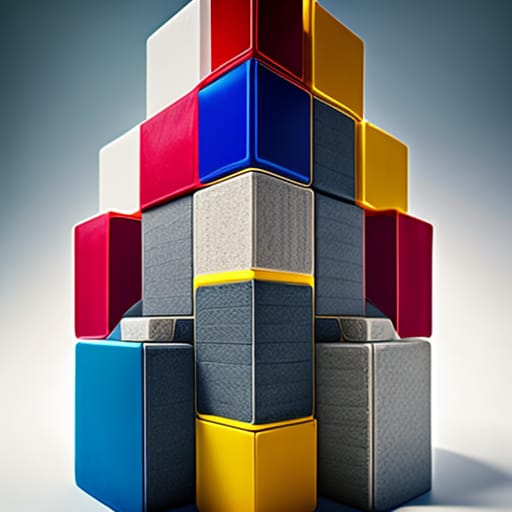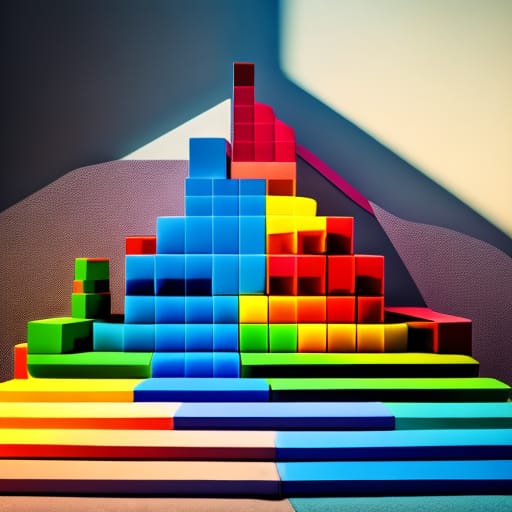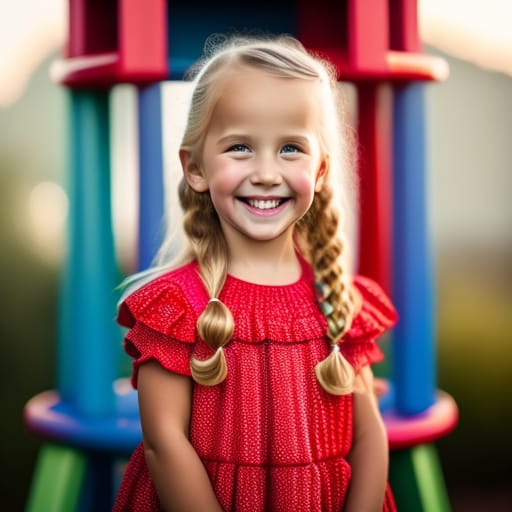Brightly colored blocks of varied shapes and sizes have long been staples of early childhood classrooms and playrooms around the world. More than just fun toys, building blocks offer a wealth of developmental and educational benefits that make them perfect tools for enriching the growth of 5-year-olds.
As children stack, arrange, knock down, and rebuild structures and patterns using toy blocks, they build critical cognitive, motor, social-emotional, and language skills. Block play also sets the stage for key skills in literacy, mathematics, and science.
This beginner’s guide will explore the key developmental domains impacted by building blocks. We’ll also provide tips, examples, and resources to help parents, teachers, and caretakers successfully incorporate block play into settings for 5-year-olds.
Why Are Building Blocks Important Developmental Tools?
Free, unstructured block play utilizing colorful toy blocks builds a sturdy foundation across essential domains:
- Cognitive development: Block play enhances visuospatial skills, hand-eye coordination, problem-solving abilities, attention and concentration skills.
- Motor development: Stacking, balancing, and manipulating blocks develops fine motor control and dexterity.
- Social-emotional development: Collaborative building promotes sharing, cooperation, turn-taking and imaginative play.
- Language development: Block structures spark dialogue and narrative, expanding vocabulary and syntax.
- STEM learning: Patterns, spatial reasoning, cause-and-effect, measurement, and engineering concepts are intrinsically woven into block play.
In addition to inherent learning value, the open-ended nature of building blocks means play can be scaffolded to increase complexity and learning over time. Used creatively, blocks unlock rich opportunities at any developmental stage from ages 1 through 12.
Key Stage 1 Building Blocks: Enhancing Literacy and Vocabulary
Key Stage 1 spans ages 5-7 in the UK, covering the first years of primary school. This period sees momentous leaps in language and literacy.
Building blocks dovetail beautifully with Key Stage 1 instruction, reinforcing high-frequency vocabulary words and phonics skills learned in the classroom. Simple word building games with blocks boost sight word recognition and spelling skills.
As children construct and describe block structures, new vocabulary terms are seamlessly introduced. Spatial words like “between”, “around” and “through”, size words like “tall”, “long”, and “small”, ordinal words like “first”, “second” and “third”, and descriptive words like “curvy”, “wobbly” and “crooked” enrich expressive language.

Building Block Play Unlocks Educational Insights
The interplay between hands, eyes and brain during block building strengthens neuronal pathways, forging cross-connections that fuel learning across developmental domains.
Analysts have identified over 700 mental processes utilized in manipulating blocks, including visualization, symbolic representation, abstraction, comparison, pattern perception, one-to-one correspondence, and part-whole relations.
Beyond impressive cognitive impacts, decades of research has shown positive correlations between block play and:
- Increased spoken vocabulary and lengthier verbal interactions
- Enhanced mathematical thinking and measurement abilities
- Improved ability to focus attention and persist at tasks
- Gains in spatial structure and geometry understanding
- Growth mindset towards learning through trial-and-error
These broad educational insights underscore why block play should be central in early childhood settings.
Developmental Domains Impacted by Building Blocks
Now let’s explore specifics of how building blocks enrich development across domains during Key Stage 1 years.
Cognitive Development
As young architects envision structures, stack blocks purposefully, and problem-solve when buildings topple unexpectedly, block play exercises key cognitive competencies.
Spatial Skills
Analyzing shape, size and position of blocks in 3D space builds acuity for spatial relationships. Strong spatial sense feeds into early geometry, measurement, reading comprehension and more.
Executive Function
Maintaining focus on detailed block structures over sustained periods develops working memory and self-regulation – core executive functions that underpin success with goal-directed activities.
Problem Solving and Critical Thinking
Trial and error is intrinsic to block play. Assessing structural stability, reworking designs, learning from failures – this process strengthens flexible thinking, analysis and critical problem-solving abilities.
Social-Emotional Development
The simple act of playing alongside peers provides 5-year-olds opportunities to share toys and take turns as they co-create block structures.
Collaborative building projects allow practice with compromise, communication clarity, task allocation, and appreciating diverse ideas as children navigate group dynamics.
Enacting stories with block creations builds confidence with symbolic representation and self-expression.
Language and Literacy Development
Early literacy blooms as young children engage with blocks! Alphabet blocks with letters, sight words or phonics patterns allow for playful reinforcement of reading concepts.
Labeling block structures, counting component pieces, describing observations – such narration expands both receptive and expressive vocabulary and syntax foundation.
Classifying blocks by color, size or shape builds category differentiation and comparison facility central to developing analytic capabilities.
As children gain fine motor control they can even begin using blocks for writing activities, spelling out names or copying simple sentences.
Recommended Toy Building Blocks for Ages 5-7
With the powerful developmental impacts of block play validated, what are the best building block options to catalyze 5-year-old growth?
Classic Wooden Unit Blocks
These uniform unfinished maple wood blocks in squares and rectangles allow for endless creativity. Following set standards for durable precision-cut blocks optimizes play value.
- Dimensions tailored for small hands
- Inspires imaginative structured block play
- Timeless aesthetic, heirloom quality
Rainbow Building Stones
Vibrant colors inject energy and visual distinction to sort shapes and sizes. Color-coding expands play themes and pattern options. Distinct edges facilitate balance and height in ambitious structures.
- Variety stimulates creativity
- Vivid colors promote color & shape recognition
- Durable smoothed plastic easy to clean
Giant Foam Blocks
Oversized soft blocks in bright colors build eye-catching Forts and Castles. Thick Jumbo foam pieces interlock firmly and are easy to sculpt to add paths, moats and textures. Gentle fabric coating allows indoor/outdoor play.
- Great for gross motor development
- Enhances cooperative social play
- Vented for light weight
Jumbo Cardboard Blocks
These sturdy jumbo-sized biodegradable structured block sets promote collaborative young engineers. The chunky hand-sized cubes connect securely to build kids’ bold imaginative designs.
- Ultra-light, easy to handle
- Promotes STEM concepts
- Eco-friendly

Getting the Most Benefit from Building Blocks
While blocks themselves invite play and discovery, a few simple enhancements can turbo-charge cognitive gains:
- Allow lots of open-ended unstructured time for experimentation
- Occasionally suggest challenges to stretch construction or spatial skills
- Engage dialog by asking open-ended questions during block play
- Introduce new vocabulary words through labeling and describing structures
- Provide props like toy figures to spur storytelling with block creations
- Regularly rotate block sets to maintain novelty and inspiration
With consistent access in supportive play environments, building blocks offer 5-year-olds endless opportunities to unlock developmental gains that will serve them for life. Let the play begin!
Frequently Asked Questions
What are the benefits of block play?
Block play provides a wealth of cognitive, social-emotional, motor, and language benefits. It enhances visuospatial skills, hand-eye coordination, problem-solving, attention skills, imagination, sharing, cooperation, vocabulary, and early STEM skills.
What are the best blocks for 5-year-olds?
The best blocks for 5-year-olds are classic wooden unit blocks, rainbow building stones, giant foam blocks, and jumbo cardboard blocks. Key features to look for are color variety, durable construction, small hand-sized pieces, and compatibility for structural stability.
How do blocks help with language development?
As children engage in collaborative block play and describe their structures, this narration helps expand vocabulary and communication skills. New spatial words, size descriptors, numbers and categories are incorporated organically.
What math concepts can be learned from blocks?
Blocks facilitate learning STEM concepts like patterns, measurement, symmetry, geometry, counting, grouping, spatial reasoning, fractions, and early engineering principles through balanced structures.
How can I encourage more creative block play?
To spur imagination, provide small figures of people, animals and vehicles. Ask questions about your child’s structures. Suggest new building ideas. Introduce props like roads, signs or flags. Rotate between different block sets periodically.
What are signs that my child enjoys block play?
Engaged, sustained focus while building, preference for building over other toys, seeking more complexity in structures, excitement retelling stories around structures, and eager collaboration with other children.
Are there safety issues I should consider with blocks?
Ensure loose small pieces not accessible to toddlers. Supervise first use of jumbo blocks. Remind children not to throw blocks or hit each other. Watch balance of high narrow builds. Follow age guidelines for block sets.
